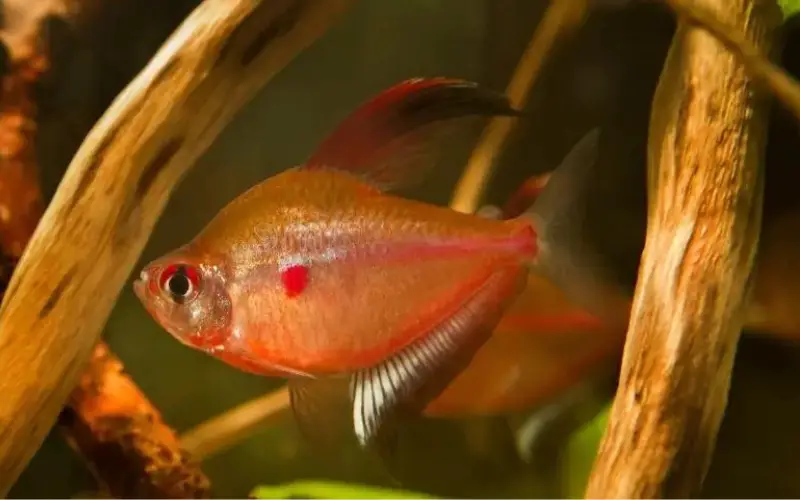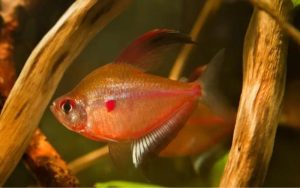How can you tell bleeding heart tetra male vs female? Bleeding Heart Tetras are popular freshwater fish known for their vibrant red coloration around their gills, giving them their unique and distinctive name.
While they are commonly kept in home aquariums due to their peaceful nature and ease of care, many fish enthusiasts have trouble distinguishing between male and female Bleeding Heart Tetras.
In this tetra care guide, we will explore the subtle differences between male and female Bleeding Heart Tetras, including physical characteristics and behavioral traits that can help you identify your fish’s sex.

By understanding these differences, you can better care for and breed your Bleeding Heart Tetras, ensuring a harmonious and thriving aquarium environment.
So, if you’ve ever wondered how to spot the difference between a male and female Bleeding Heart Tetra, read on to learn more.
Table of Contents
ToggleDifferences Between Bleeding Heart Tetra Male Vs Female
The male is characterized by more extended dorsal and anal fins, whereas the female is more voluminous and has a bigger dorsal fin. The dorsal fin extends to form a sickle shape that curves to match the length of the base of the tail. The female’s fin is rounder and shorter.
Distinguishing between male and female Bleeding Heart Tetras (Hyphessobrycon erythrostigma) can be tricky, even for experienced aquarists. Here’s what to look for:
Bleeding Heart Tetras male vs female (Primary Differences)
- Size: Males are typically slightly smaller than females.
- Coloration:
- Males: Have brighter red coloration on their “bleeding heart,” especially during breeding season. The black “eye” in the heart is also more pronounced.
- Females tend to have a paler, more orange-red heart, and the black “eye” may be less prominent.
- Body Shape: Females tend to have a slightly rounder belly, especially when full of eggs.
Secondary Differences (Less Reliable)
- Fins: Some sources suggest that males have longer, more pointed fins, which is only sometimes.
- Behavior: During breeding season, males may be more aggressive towards each other and display courtship behaviors, such as chasing females.
Important Note: These differences can be subtle, and there is a lot of variation within individual fish. It’s often easier to tell the sexes apart with certainty if they are breeding.
Tips for Sexing Bleeding Heart Tetras:
- Observation: Observe the fish over time and look for subtle differences in coloration, body shape, or behavior.
- Breeding: If you want to breed them, you can try to observe any courtship behavior or egg laying.
- Multiple Specimens: If you have a group of fish, it might be easier to distinguish the sexes by comparing them.
Remember, sexing Bleeding Heart Tetras is not an exact science. If you are uncertain about your fish’s sex, it is always best to err on the side of caution and assume they are mixed sex. This will help ensure a healthy and harmonious environment in your aquarium.
Bleeding Heart Tetra Male Vs Female Behavior & Temperament
The males and females of this fish species exhibit different behaviors and temperaments. Male Bleeding Heart Tetras are typically more colorful and aggressive, especially during the spawning season. They may exhibit fin-nipping behavior towards other tank mates.
On the other hand, female bleeding heart tetras tend to be more docile and may prefer to go to school with other females. In terms of lifespan, Bleeding Heart Tetras can live for a relatively small longevity, with proper care and a high-quality diet.

When it comes to tank setup, these peaceful fish prefer a tropical environment with acidic water and sandy substrate, which provides ideal breeding conditions.
Male Bleeding Heart Tetras are known for their attractive red spot, which is more prominent than in their female counterparts. They also have a sickle-shaped dorsal fin, adding to their captivating appearance.
In their natural habitat of the Upper Amazon, Bleeding Heart Tetras inhabit slow-moving streams and tributaries with ample vegetation and fallen branches. To replicate this environment within the aquarium, driftwood should be included, vegetation planted around it, and hiding spots provided for these beautiful fish.
Bleeding Heart Tetra Sexual Dimorphism
Bleeding Heart Tetras exhibit an evident sexual dimorphism, meaning the males and females have distinct physical characteristics. Here’s a breakdown of the differences:
- Fins: The most noticeable difference is in the fins. Males possess significantly longer and more flowing dorsal and anal fins. The dorsal fin can extend back to the tail base and take on a sickle shape, while the female’s fins are shorter and more rounded.
- Body Shape: Females tend to have a rounder, fuller body than males. This is because females carry eggs, and their bodies need more space to accommodate them. Males, on the other hand, are typically slimmer and more streamlined.
Observing these features together allows you to quickly sex Bleeding Heart Tetras.
Bleeding Heart Tetra Care Information & Tank Set Up
When caring for Bleeding Heart Tetras, many factors must be considered to ensure they thrive in your tank. These peaceful, small fish can be kept with other tetra species, hatchetfish, catfish, and even tiger barbs.
However, it is essential to note that Bleeding Heart Tetras don’t get along with aggressive fish or those that might stress them out. Therefore, keeping them in a separate tank is best to maintain their stress levels low.
These fish are omnivores and will scavenge for food like bloodworm, brine shrimp, and even lettuce. They are low-maintenance and beginner-friendly, making them an excellent choice for aquarists of all levels.
When setting up a tank for Bleeding Heart Tetras, it is crucial to consider the water parameters. These fish originate from the Amazon basin, where the water is low in pH and contains tannins.
You can encompass the tank with driftwood and dried oak leaves to mimic their natural habitat. Providing a bare minimum of 20 gallons of water is recommended for a school of these tetras. Keep the temperature between 75-82°F and perform regular water changes to prevent common diseases like ich and fin rot.
Commonly Asked Questions about Bleeding Heart Tetra Male Vs Female (FAQs)
How do you know if a tetra is male or female?
How can you tell male from female tetras? Elling tetras apart is tricky! Look for a rounder belly and a slightly curved blue line – likely a female. Males are slimmer with a straighter blue line.
Are bleeding heart tetras aggressive?
Bleeding heart tetras are peaceful fish. However, if kept in a small group, they can become fin nippers toward other fish. To ensure a harmonious tank, keep them in schools of at least 6 with plenty of hiding spots.
Do bleeding heart tetras eat plants?
Bleeding heart tetras are omnivores but primarily eat meaty foods. They won’t harm healthy plants in your aquarium. While they might nibble on soft leaves, it’s not a primary food source.
What does a female tetra fish look like?
Female tetras are generally rounder than males, with a fuller belly. They often have less vibrant colors than males, with a more muted or silvery sheen.
Can tetras change gender?
No, tetras are born male or female and cannot change genders. Some species may look similar when young, but males develop distinct features as they mature.
Do bleeding heart tetras lay eggs?
Yes, bleeding heart tetras are egg-laying fish. They scatter their eggs among plants and crevices. The eggs hatch in a few days, but the fry needs to be removed from the tank to avoid being eaten by the parents.
Are bleeding heart fishes hardy?
Yes, bleeding heart tetras are considered hardy fish! They can tolerate various water conditions and are peaceful community tank residents.
What is the habitat of the bleeding heart tetra?
The bleeding heart tetra inhabits slow-moving, shallow areas of the Upper Amazon Basin, including streams, creeks, and lake edges. These areas are often shaded and acidic, with plenty of aquatic plants and submerged wood.
Conclusion
In conclusion, the world of aquarium fish always amazes us with its diversity and beauty. The Bleeding Heart Tetra is a stunning species that captures our attention with its vibrant colors and graceful movements. Whether you choose a male or female Bleeding Heart Tetra for your tank, both genders possess unique qualities that make them fascinating to observe.
While the male Bleeding Heart Tetra displays vibrant red markings on its body, the female showcases a more subtle coloration. It’s important to note that these differences in appearance are not the only factors to consider when selecting your fish. Understanding the behavior and social dynamics of these fish is equally crucial.
Knowledge about the Bleeding Heart Tetra’s characteristics is key to creating a harmonious aquarium environment. By understanding the distinctions between the male and female Bleeding Heart Tetras, you can make informed decisions and foster a thriving community within your tank.
So, whether you’re captivated by the striking colors of the male or appreciate the understated elegance of the female, both Bleeding Heart Tetras bring their charm to your own aquatic world. Next time you find yourself contemplating the mesmerizing world of fish, take a moment to appreciate the unique qualities of the Bleeding Heart Tetra male vs female.
Recommended posts
- Bleeding Heart Tetras Fish 101: A Comprehensive Aquatic Guide
- Bleeding Heart Tetra Size 101: (A Comprehensive Care Guide)





